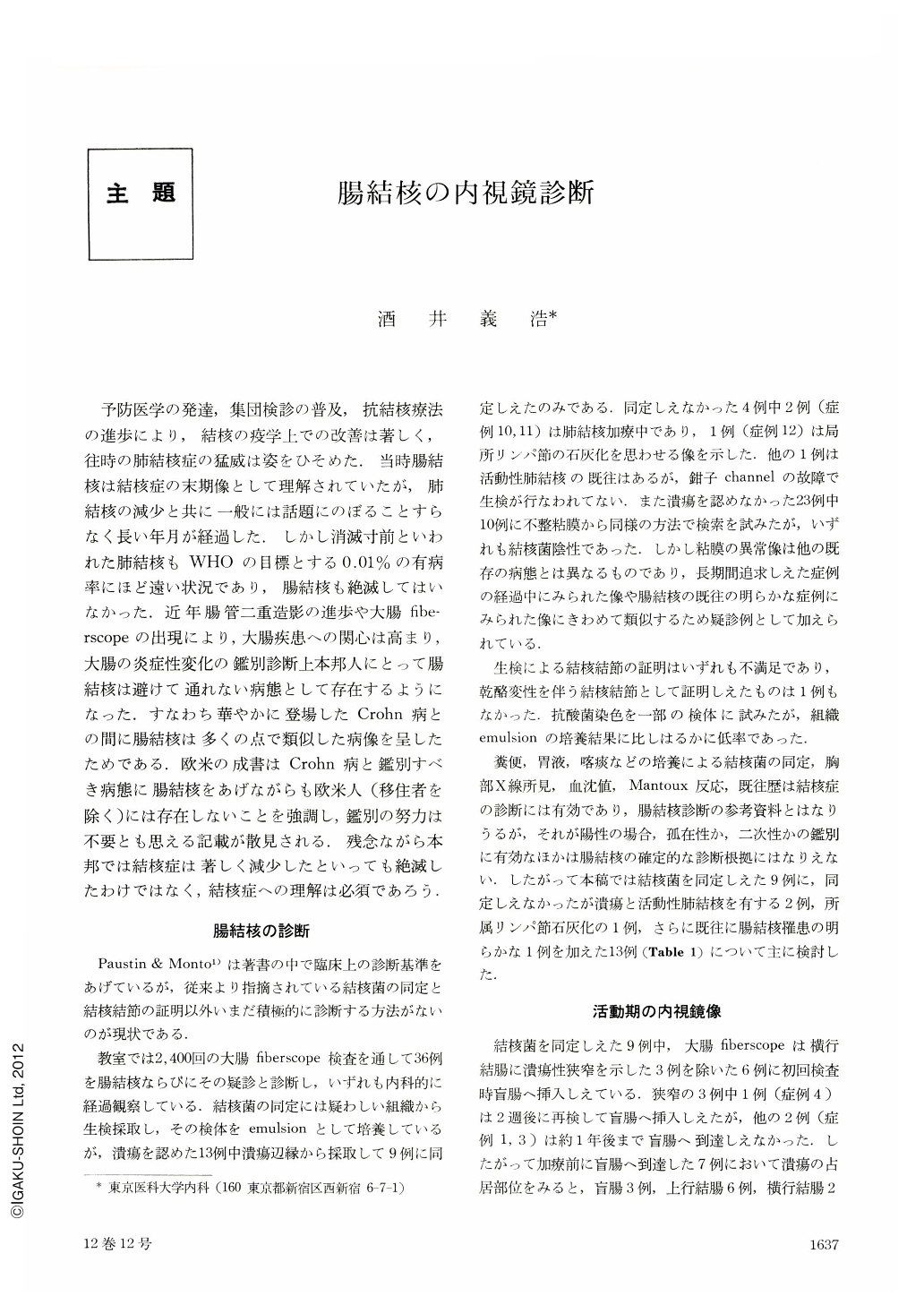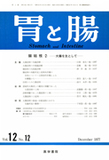Japanese
English
- 有料閲覧
- Abstract 文献概要
- 1ページ目 Look Inside
- サイト内被引用 Cited by
予防医学の発達,集団検診の普及,抗結核療法の進歩により,結核の疫学上での改善は著しく,往時の肺結核症の猛威は姿をひそめた.当時腸結核は結核症の末期像として理解されていたが,肺結核の減少と共に一般には話題にのぼることすらなく長い年月が経過した.しかし消滅寸前といわれた肺結核もWHOの目標とする0.01%の有病率にほど遠い状況であり,腸結核も絶滅してはいなかった.近年腸管二重造影の進歩や大腸fiberscopeの出現により,大腸疾患への関心は高まり,大腸の炎症性変化の鑑別診断上本邦人にとって腸結核は避けて通れない病態として存在するようになった.すなわち華やかに登場したCrohn病との間に腸結核は多くの点で類似した病像を呈したためである.欧米の成書はCrohn病と鑑別すべき病態に腸結核をあげながらも欧米人(移住者を除く)には存在しないことを強調し,鑑別の努力は不要とも思える記載が散見される.残念ながら本邦では結核症は著しく減少したといっても絶滅したわけではなく,結核症への理解は必須であろう.
腸結核の診断
Paustin & Monto1)は著書の中で臨床上の診断基準をあげているが,従来より指摘されている結核菌の同定と結核結節の証明以外いまだ積極的に診断する方法がないのが現状である.
Among 2,400 examinations using long colonoscope since 1969, 36 cases were diagnosed as tuberculous enterocolitis including one highly suspected case. Of these, 13 cases revealed some ulcers of various size and shape in the large bowel. The tubercle bacillus was cultured in only nine cases, in which specimens were taken from the margins of ulcer. In four cases with negative failed culture, two cases had active pulmonary tuberculosis under medical treatment; another one case showed a calcification of the regional lymph node and a past history of pulmonary tuberculosis; and in the remaining one case biopsy was not done due to the breakdown of biopsy channel. The last case was excluded from this series and one case was added instead who had a definite past history of tuberculosis. All cases were followed up medically.
Before the antituberculosis therapy, the main lesion in the large bowel was a large irregular-shaped ulcer in 6 of 9 definite tuberculous enterocolitis. Of the remaining three cases, two revealed a circular ulcer and another showed a longitudinal ulcer. Those ulcers were most often located in the ascending colon, followed in the order of frequency by those in the cecum and transverse colon. Endoscopic view of ulcers was quite variable without any absolute characteristic findings. There were no marginal undermining or uneven slough but they already had a tendency to ulcer healing and cleaning out of slough in spite of long period of complaints. The mucosa surrounding ulcer was edematous in one case and hyperemic but stable with polypoid change in the remaining eight. Usually the mucosa between ulcers was not involved by the inflammatory process.
The ileocecal junction was markedly deformed with stenoinsufficiency except for one case with a circular ulcer in the ascending colon. This was quite common in highly suspected 23 cases. The terminal ileum was generally atrophic with complete disappearance of lymph follicle and only one case had a few small ulcers scattered around 15 cm from the ileocecal junction. In highly suspected cases, however, four cases of lymph follicle hyperplasia were noted with scar in the large bowel and in particular vanishment of the cecum. Lymph follicle of the terminal ileum seems to have a close relationship to the cecum, immunologically or due to unknown mechanism.
In the healing phase, although the scar formation seemed to be prominent, even endoscopic deep ulcer did not always leave a scar with convergence. In fact only one case showed a scar with convergence in 12 active cases. Sacculation, inflammatory polyps and mucosal bridge were also seen among long follow-up cases.
Initial figure of this lesion must have been a hyperplasia of the diseased lymph follicle which made it difficult to diagnose in this stage. Therefore a tiny ulceration at the top of lymph follicle could be found under colonoscopy, which must be quite similar to the aphthoid ulcer in Crohn's disease.
For the endoscopic diagnosis of the tuberculous enterocolitis, many biopsies from the margins of ulcers are most important for the culture of tubercle bacillus and histologic detection, when an ulcer was found in the large bowel and/or terminal ileum. Once the antituberculosis therapy has been started, however, results would often be poor. Moreover, in the later stages diagnosis becomes much more difficult. Follow-up observation for long period under medical control is necessary to get further information for the diagnosis.

Copyright © 1977, Igaku-Shoin Ltd. All rights reserved.


